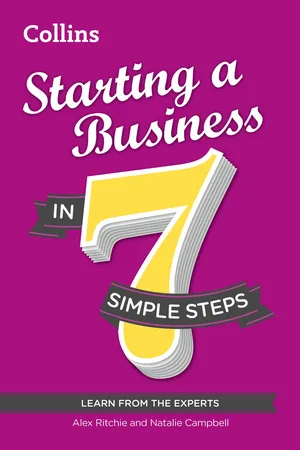
This is a test
- English
- ePUB (mobile friendly)
- Available on iOS & Android
eBook - ePub
Starting a Business in 7 simple steps
Book details
Book preview
Table of contents
Citations
About This Book
7 simple steps to a successful start up
Frequently asked questions
At the moment all of our mobile-responsive ePub books are available to download via the app. Most of our PDFs are also available to download and we're working on making the final remaining ones downloadable now. Learn more here.
Both plans give you full access to the library and all of Perlego’s features. The only differences are the price and subscription period: With the annual plan you’ll save around 30% compared to 12 months on the monthly plan.
We are an online textbook subscription service, where you can get access to an entire online library for less than the price of a single book per month. With over 1 million books across 1000+ topics, we’ve got you covered! Learn more here.
Look out for the read-aloud symbol on your next book to see if you can listen to it. The read-aloud tool reads text aloud for you, highlighting the text as it is being read. You can pause it, speed it up and slow it down. Learn more here.
Yes, you can access Starting a Business in 7 simple steps by Alex Ritchie, Natalie Campbell in PDF and/or ePUB format, as well as other popular books in Business & Business Skills. We have over one million books available in our catalogue for you to explore.
Information
Step 1
KNOW YOUR BUSINESS
‘The secret of getting ahead is getting started.’
— Mark Twain (1835–1910), American author
— Mark Twain (1835–1910), American author
Five ways to succeed
- Start a business you believe in.
- Use your skills, experience and contacts.
- Be ambitious with your vision and aims.
- Identify what differentiates your business – your USP.
- Understand your market and customers.
Five ways to fail
- Underestimate your customer.
- Believe you’ll get rich quickly.
- Assume you can work all day, every day.
- Fail to make the most of your network.
- Ignore the tax man.
What kind of business will you run?
So, you know that you want to run your own business. You have a few ideas in mind that get you excited but how do you decide where to start?
Your passion, skills and experience
Take a good look at yourself. Is there something you’re particularly passionate about? Have you always wondered whether you could turn your passion into a business? You may have a talent or skill which would enable you to start a business in a certain field, such as hairdressing or baking. Or you might be a professional, such as a lawyer, dentist or physiotherapist, and have realized that, rather than working for someone else, you now have the skills and experience to set up your own practice. Alternatively, you have identified a problem in your community that you think you might just have a solution for, or maybe you’ve come up with an idea that would make your life or the lives of others much easier. These could be a great starting point for deciding what your business will be. Dame Anita Roddick started up her business, The Body Shop®, after realizing a passion for producing and retailing beauty products that prohibited the use of ingredients tested on animals. Maurice and Charles Saatchi founded the advertising agency Saatchi and Saatchi after gaining years of experience and skills, along with influential contacts in the world of advertising.
Got a few ideas – now what?
If you have one or more ideas that you think you’d like to try, draw up a list of pros and cons. Think about all aspects of the business, such as the number of hours per day you’ll need to work and the cost of any necessary equipment. Running a café will require a different amount of time to setting up as a consultant. Estimate how much money you’re likely to make and what your running costs are likely to be.
List everything you can think of; you may find that some items appear as both a pro and a con. Once you have your list, go through each point, particularly the cons, and think about the implications. Are they small hurdles or big issues? Do you have any solutions?
Idea 1: Artisan bakery
Pros:
- I love to bake and experiment with new culinary ideas.
- There’s nothing similar in my local area.
- It has good profit potential.
- I could set up an online offering alongside the shop.
- I could sell to consumers as well as to cafés or restaurants.
Cons:
- I’d need premises.
- I’d need to work long hours to make it work.
- There would be high start-up costs.
- I’d need to understand food hygiene and health and safety.
- I’d need to monitor fluctuating prices for ingredients.
The unique selling point (USP)
What makes your chosen business different from the others out there in the same sector or marketplace? Consider what might make your potential customers buy from you rather than your competitors: what makes you different, and is there a genuine need for your product or service?
Have a look around at the competition and use the internet or business sections of your local library to research your competitors. Consider different ways you might differentiate your business. For example, you could offer:
- high quality customer service.
- fast or free delivery on goods.
- cheaper prices.
- additional support packages, such as free telephone support.
- highly qualified staff.
- creative or new services.
Is there a need for your business?
Have you spotted a gap in the market? Maybe there’s no one else providing these goods or servicing your potential marketplace. A word of caution here: the gap may be there for a good reason. Maybe it’s not a financially profitable offering because the marketplace for these goods or services is just too small, or the manufacturing or shipping costs are very high. Research the need for your business and check out whether it has been tried before and if so, why those businesses failed or moved out of the market.
You’ve chosen the idea – what’s next?
Vision
You should create a vision for your business. Your vision is what you describe to people when explaining your idea, and it should be easily understood by those you want to sell to. It can be big and aspirational or it can be succinct and to the point. It should be your inspiration for the future of the company. It’s worth reading about the vision your competitors have or the vision behind brands that you really like; this will give you an understanding of what might work for your business. For example, when Bill Gates first started Microsoft, he envisioned a personal computer in every home and business.
Aims
The aims of your business are more practical and operational than your vision. They’ll change over time as your business grows. Your aims will usually be two or three things that you hope your business will do. An aim might be something like ‘sell 3,000 cupcakes in the first year’ or ‘supply my goods to a leading manufacturer in my industry by a specific date’. Having aims keeps you focused on what success looks like in a more manageable way than a vision, which might take years to fulfil.
Choosing a name
You’ve managed the hard part. You’ve come up with an idea that fulfils your passion and is potentially profitable. You’ve got a vision and aims. Now you need to think about a name. This helps to make your idea real so you can start sharing it and getting feedback on your concept. There’s no science to this. You need a piece of paper, a pen and maybe a few friends, but start writing whatever comes to mind. Here are some things to consider.
- Do you want a business name that says what it does on the tin?
- Do you want to stand out with something less conventional or even radical?
- Do you want to fit in with your competitors or is there an industry norm?
When considering the above, think about your industry sector, competitors and customers. This should help you to weigh the advantages and disadvantages of each. Once you’ve got a few names you like, ask people what they think; you can change your mind right up until the minute you register the business.

Different business types
Product- versus service-based business
Product-based businesses sell ‘things’ to their customers. They may sell to ordinary people like you and me: this is called business to consumer (B2C). On the other hand, they could sell to other businesses: this is called business to business (B2B). Popular B2C product-based businesses are retailers selling clothing, homeware, books, music, etc. In fact, the list is endless. B2B product-based businesses typically supply products that other businesses or institutions need as part of their own production process, for example, widgets, machinery, medical equipment, wholesale clothing and IT equipment.
Service-based businesses utilize your skills, time and talent. Think cleaning companies, day-care and consultancies. Service-based businesses can also be B2C or B2B.
Some businesses can sell both services and products, for example, cafés and restaurants. We see more and more of these service-based businesses acting as retailers, selling goods alongside core service. We discuss this further here.
Both types of business might require start-up capital but if you’re a product-based business, it’s likely that you’ll need to purchase goods and pay for distribution or premises, whereas many service-based businesses can be started on a shoestring.
Business to business or business to consumer
When it comes to choosing between business to business (B2B) and business to consumer (B2C), you might not have to. Both markets might be profitable and keep you busy throughout the year. Consider offering your services direct to customers and businesses. Take, for example, a café that supplies offices or offers large-scale catering services and caters for walk-in trade as well.
If you can service both markets, you’re providing yourself with a much broader target market, which could help the business to succeed in difficult times. For example, if you were setting up a florist but found that a competitor or a local branch of a supermarket had set up over the road and was beginning to undercut your prices, you might be thankful that you’d started supplying to weddings and venues and built a relationship with the local funeral directors.
Setting up an online business
These days, starting a business online can be a low risk entry point. You don’t even have to build your own website any more as third-party...
Table of contents
- Title Page
- Contents
- Step 1: Know your business
- Step 2: Form a business plan
- Step 3: Create your identity
- Step 4: Sell your product or service
- Step 5: Set up your office and staff
- Step 6: Grow your business
- Step 7: Review your business and progress
- Keep Reading
- About the Authors
- Copyright
- About the Publisher